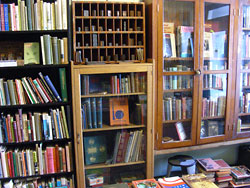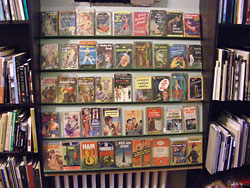Young Collectors: An Emerging Market?
Booksellers weigh in on the next generation of book collectors By Jason Dickson Jason Dickson is the author of Clearance (2002), The Hunt (2006), Glenn Piano by Gladys Priddis (2010) and is the proprietor of the Muskoka Bookhouse, an antiques and collectibles bookshop in Bracebridge, Ontario, Canada.

Those in the bookselling community regularly ask themselves, where will the new generation of collectors come from? Given the age of many serious collectors, the influence of the Internet, and the seeming disinterest many younger people exhibit when it comes to books, fears have spread that we are in the twilight of the antiquarian and collectible book trade.
But look a little deeper and it may not seem so grim. As in the past, the antiquarian trade has always seemed to be under the gun from one cryptic influence or another. Yet it has survived. And there are many booksellers and young people who have grown up embracing recent influences (namely electronic media), and using them creatively in their collecting methods.
One brick-and-mortar bookseller who is facing these changes consciously and challenging the older concepts is Stephen Fowler of The Monkey’s Paw in Toronto, Ontario.
Fowler intentionally modeled his store after the image of an Old World curiosity shop, with evocative black bookcases, weird music, arcane typewriters, biological specimens, and shelves of books chosen for their value as both cultural artifacts and resources of enigmatic information. The shop intentionally encourages an atmosphere of antiquity and esotery. Needless to say, it is a big hit with the young people.
“I try not to have the air of pomposity that many bookshops have,” Fowler said recently, adding that, despite the idiosyncratic character of his shop’s design, he remains an approachable presence. “I was a cool lay-about in a hip city, just like them.”
Fowler explained that although a lot of his young customers are very smart and cultured people, they are simply not aware that there is a history of book collecting. To them, you buy a book, and maybe another, but there is no coherence, or growth, to the activity.
But how could they know this, asked Fowler, when most became readers in an age when serious bookstores were closing?
“All of a sudden bookstores became a complete anachronism,” he said. “So I play that up. One thing that books have over electronics is their anachronism.”
According to Fowler, books to a younger collector have a very different meaning than they do to a collector from the pre-Internet days. In the past people bought books mostly to read them. It was a practical thing. The distance required to view them as artifacts did not exist.
To a young collector, however, who does not see a book as the primary source of culture, it is essentially an artifact. So a bookseller working today must know this and embrace it, instead of resisting it, as many do.
“To them it all seems incredibly antique,” he said. “They all think it’s a cool object. But they have no idea why it’s worth $50.”
So Fowler actively cultivates the collecting impulse in his younger customers. He shares his knowledge of the trade and hopes that his shop will exhibit an approach toward books that is both historical and contemporary.
Fowler admitted, though, that he does not see many systematic collectors in his younger clientele.










